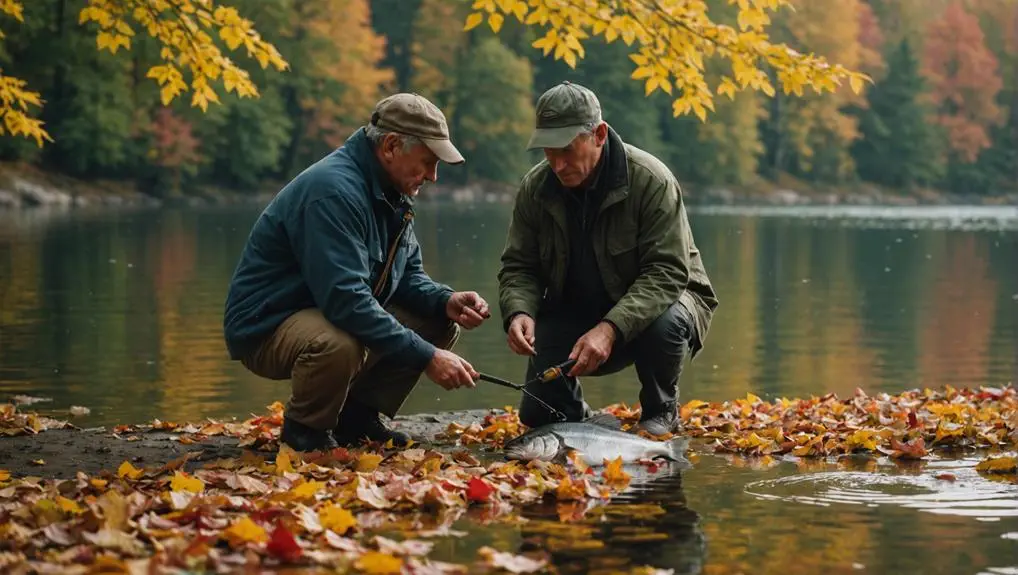Preparing fish for seasonal temperature shifts can really enhance both flavor and quality. As temperatures rise, fish get more active—perfect for grilling or baking with fresh veggies in spring. During the summer heat, fish tend to chill in cooler depths, so target those spots early in the day. Come fall, fish feast to prepare for winter, so hearty ingredients like squash can create delightful dishes. In winter, focus on gentle cooking methods like poaching to keep everything tender and delicious. Curious about how to really nail those seasonal flavors? There's so much more to explore!
Contents
Understanding Temperature Effects on Fish
Fish, much like a well-tuned engine, rely on their surrounding water temperature to dictate their metabolism and behavior.
Warmer water not only increases their activity levels but also affects their oxygen needs, as temperature impacts dissolved oxygen. You'll notice that as water temperatures rise in spring, fish become more active and hungry. This is the perfect time to adjust your fishing strategies to take advantage of their appetites.
Think of it as a buffet—when the food's plentiful, they're ready to feast!
In summer, when the weather heats up, fish often retreat to cooler, deeper waters. They're less active during the hottest parts of the day, so you might want to fish early in the morning or later in the evening.
Fall brings a different challenge. As temperatures decline, fish start feeding aggressively to store energy for winter. This change can guide you to their foraging patterns.
Spring Cooking Techniques
As temperatures rise in spring, it's time to shake up your cooking techniques for fish. With warmer water, fish species like trout and bass are coming alive, and their flavor and texture are at their best. You want to cook these beauties to an internal temperature of 145°F (63°C) for safety and to really bring out that delicious taste.
Think about grilling, baking at 350°F (175°C), or pan-searing. These cooking techniques can help keep your spring-caught fish moist and flaky. Don't forget to incorporate fresh, seasonal spring vegetables and herbs; they'll elevate your dish and complement the fish beautifully.
You might also want to experiment with lighter methods like poaching or steaming. These techniques preserve the natural taste of the fish, making it shine.
Just remember, timing is everything! Adjust your cooking duration carefully, as spring fish can have enhanced flavors that you definitely don't want to overpower.
Summer Preparation Strategies

With summer's heat setting in, your approach to fishing and preparing fish needs to evolve. As the water temperature rises, fish seek refuge deeper into the water to escape the heat. This means you'll need to adjust your strategies for greater success.
On those sunny days, target those cooler spots in the early morning or late evening when fish are more active and ready to feast.
To catch fish at these depths, consider using deeper-diving lures that can reach those cooler temperatures where fish feel more comfortable. It's amazing how a little change in your tackle can have a significant impact on your catch!
Also, don't forget to wear Bajío Blue or Green Mirror lenses on bright days. They'll help reduce glare, making it easier to spot fish hiding in the shadows.
And remember, monitoring water temperature is crucial. Warmer water can stress fish out, influencing their feeding habits and overall health.
Fall Flavor Enhancements
Autumn brings a delightful shift in flavors, making it the perfect time to elevate your fish dishes. As temperatures cool, fish often turn to high-protein foods, and you can take this cue to incorporate hearty ingredients.
Think about using seasonal produce like root vegetables and squash; they provide a wonderful contrast to the rich flavor of the fish.
Don't shy away from exploring new cooking techniques during these autumn months. Smoking or roasting fish not only enhances its natural taste but also adds a comforting warmth to your meal.
To really kick things up a notch, bring in strong spices and herbs like sage, thyme, and paprika. These flavors work beautifully with the fish, making each bite a delightful experience.
When cooking fish, aim for a slightly higher temperature of around 145°F (63°C). This helps keep the fish moist while ensuring all those rich flavors are fully developed.
So, gather your loved ones, whip up some delicious fall fish dishes, and celebrate the season together.
With these enhancements, your meals won't only satisfy but also create lasting memories around the table. Happy cooking!
Winter Cooking Considerations

During winter, cooking fish requires special attention to detail to ensure you achieve the perfect flavor and texture.
The cold weather conditions can alter how your fish cooks, so it's essential to monitor the internal cooking temperature closely. Aim for 145°F (63°C) at the thickest part to keep things safe and delicious.
Cold water fish, like cod and halibut, often have denser textures that need gentle cooking techniques.
Think poaching or baking with a cover to help retain moisture and enhance flavor. Nobody wants dry fish, especially during the chilly months!
Don't forget about your kitchen environment! Keeping it warm helps ensure your fish cooks evenly.
And while you're at it, adjust your seasonings to match the season. Incorporating heartier ingredients like citrus and fresh herbs can really elevate the dish.
Frequently Asked Questions
How Sensitive Are Fish to Temperature Changes?
Fish are highly sensitive to temperature changes. Their metabolism shifts with thermal tolerance, affecting spawning behaviors and habitat preferences. Species diversity plays a role in cold and warm water environments, influencing their stress response significantly.
Why Are Time and Temperature Important When Preparing Fish?
Time and temperature are crucial for safety guidelines, ensuring freshness indicators are met. Proper cooking methods enhance flavor, preserve texture, and using marinating tips can elevate dishes, while correct storage techniques and serving temperatures complete the experience.
How Do Fish Adapt to Different Temperatures?
Ever wondered how fish thrive in diverse climates? They adapt through thermal tolerance, behavioral adaptations, and physiological responses, influencing metabolic rates, growth rates, reproductive cycles, habitat selection, and even species distribution in changing environments.
At What Temperature Do You Cook Fish?
You should cook fish at 145°F for safety and optimal flavor. Adjust cooking techniques for regional variations, considering ideal temperatures and texture changes to enhance nutritional content while catering to seasonal preferences and diverse flavor profiles.
Final Thoughts
As you navigate the seasons, remember that fish can be a delightful companion on your culinary journey. Whether you're grilling under the warm summer sun or warming up with a hearty stew in winter, each season brings its own flavors and cooking techniques. Embrace the changes and let your creativity flow. So, grab that fish, sprinkle on some herbs, and let's make mealtime an adventure, one delicious bite at a time! Happy cooking!












